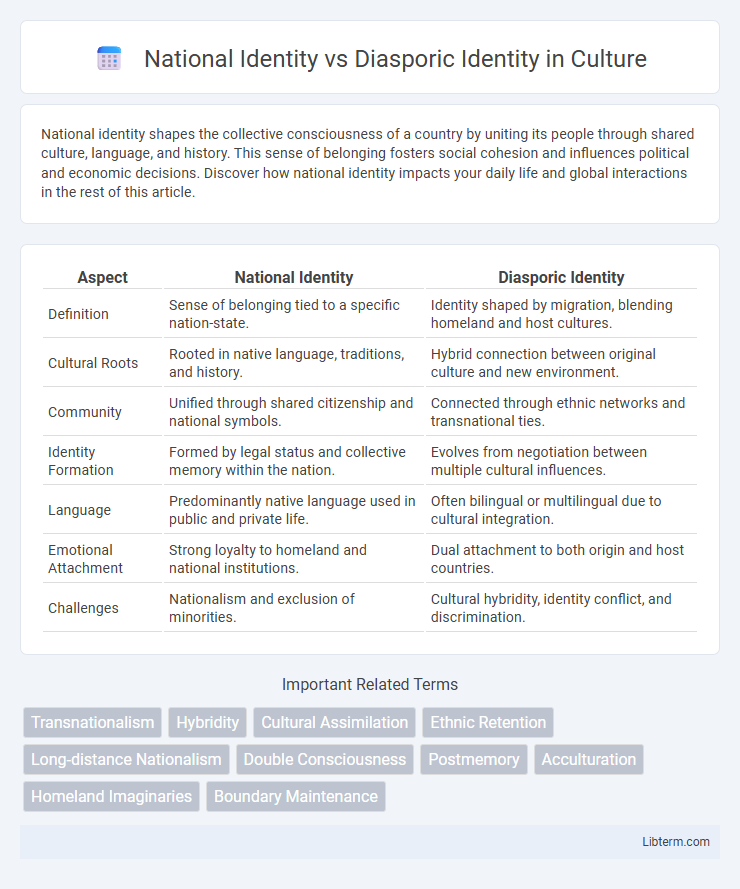National identity shapes the collective consciousness of a country by uniting its people through shared culture, language, and history. This sense of belonging fosters social cohesion and influences political and economic decisions. Discover how national identity impacts your daily life and global interactions in the rest of this article.
Table of Comparison
| Aspect | National Identity | Diasporic Identity |
|---|---|---|
| Definition | Sense of belonging tied to a specific nation-state. | Identity shaped by migration, blending homeland and host cultures. |
| Cultural Roots | Rooted in native language, traditions, and history. | Hybrid connection between original culture and new environment. |
| Community | Unified through shared citizenship and national symbols. | Connected through ethnic networks and transnational ties. |
| Identity Formation | Formed by legal status and collective memory within the nation. | Evolves from negotiation between multiple cultural influences. |
| Language | Predominantly native language used in public and private life. | Often bilingual or multilingual due to cultural integration. |
| Emotional Attachment | Strong loyalty to homeland and national institutions. | Dual attachment to both origin and host countries. |
| Challenges | Nationalism and exclusion of minorities. | Cultural hybridity, identity conflict, and discrimination. |
Understanding National Identity: Core Elements
National identity encompasses shared symbols, language, culture, historical narratives, and collective values that bind individuals within a nation-state. It serves as a foundation for social cohesion, political loyalty, and a sense of belonging rooted in territorial and institutional frameworks. Core elements include citizenship, national myths, and commemorative practices that reinforce a collective consciousness transcending individual differences.
Defining Diasporic Identity in a Globalized World
Diasporic identity in a globalized world is defined by the dynamic interplay between homeland connections and the cultural influences of host countries, creating a hybrid sense of belonging. This identity continuously evolves through transnational networks, digital communication, and the experience of migration, reflecting both preservation of ancestral heritage and adaptation to new social contexts. The complexity of diasporic identity challenges traditional notions of fixed national identity by emphasizing fluidity, multiplicity, and the negotiation of multiple cultural affiliations.
Historical Roots of Diaspora Communities
Diaspora communities often originate from distinctive historical events such as colonization, forced migration, or economic displacement, which shape their collective memory and cultural practices. These historical roots influence the diasporic identity by maintaining connections to the homeland while adapting to new sociopolitical environments. The tension between preserving national identity and assimilating into host societies highlights the complex evolution of diasporic identities across generations.
Cultural Hybridity: Where Identities Intersect
Cultural hybridity emerges as a dynamic space where national identity and diasporic identity intersect, blending traditions, languages, and values from multiple cultures. This fusion challenges fixed notions of belonging by creating fluid identities that adapt to diverse social contexts. Examining diasporic communities reveals how cultural hybridity fosters new forms of self-expression and communal solidarity beyond singular national affiliations.
Challenges of Belonging: Navigating Dual Loyalties
Navigating dual loyalties between national identity and diasporic identity often results in complex challenges of belonging, where individuals struggle to reconcile cultural heritage with the norms of their host society. This tension manifests in feelings of alienation, conflicted self-perception, and pressures to conform to competing expectations from both the homeland and diaspora communities. Balancing these dual identities requires continuous negotiation of social, emotional, and political ties to sustain a cohesive sense of self and community.
Language and Identity: Bridging or Dividing Communities
Language serves as a crucial marker of national identity by fostering a shared cultural heritage and collective memory within a homeland. In diasporic communities, language functions both as a bridge connecting individuals to their ancestral roots and as a barrier that can isolate generations from the host society. The dynamic interplay between native tongues and adopted languages shapes how diasporic identities negotiate belonging and cultural preservation across diverse social landscapes.
The Role of Media in Shaping Identities
Media serves as a powerful tool in shaping national identity by promoting shared cultural narratives and collective memory through news, films, and social platforms. For diasporic communities, media acts as a bridge connecting individuals to their heritage, allowing the preservation and adaptation of cultural practices in foreign contexts. Social media channels and transnational broadcasting expand diasporic identity by creating virtual spaces where cultural exchange and hybrid identities are continuously negotiated.
Generational Shifts: Evolving Notions of Identity
Generational shifts significantly impact the evolution of national versus diasporic identity by redefining cultural connections and loyalty across time. Younger generations in diasporic communities often blend ancestral heritage with the socio-political contexts of their birth countries, creating hybrid identities that challenge traditional notions of national belonging. These evolving identities highlight the dynamic interplay between inherited cultural narratives and contemporary experiences, influencing how individuals perceive and express their sense of self within both homeland and host societies.
Policy and Representation: State Response to Diasporic Presence
State policies toward diasporic communities shape national identity by either promoting inclusive representation or enforcing exclusionary practices, influencing diasporic integration and belonging. Governments often implement targeted citizenship laws, cultural recognition policies, and political participation frameworks to negotiate the presence of diasporas in national narratives. Representation in media and official discourses plays a critical role in framing diasporic identities, affecting both policy formation and the social cohesion between homeland and diaspora populations.
Towards Inclusive Identities: Reconciling National and Diasporic Perspectives
National identity and diasporic identity often intersect, creating complex layers of belonging that challenge exclusive definitions of citizenship and cultural affiliation. Strategies toward inclusive identities emphasize dialogue, recognizing the fluidity of cultural experiences and the legitimacy of multiple attachments beyond geographic boundaries. This reconciliation fosters social cohesion by integrating diverse narratives into a collective identity that respects both homeland connections and diasporic realities.
National Identity Infographic

 libterm.com
libterm.com